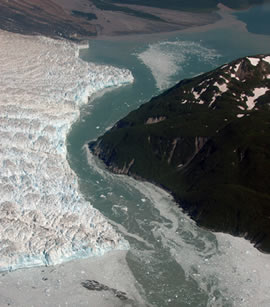
 |
|
|
July 23, 2009 Are Alaska's glaciers growing?By Ned RozellRecently, several people have contacted an editor at the daily newspaper in Fairbanks about Alaska glaciers. The editor reports that a few people claim that almost all of Alaska's glaciers are getting bigger.  Hubbard Glacier, one of the few growing glaciers in Alaska,
advances toward Gilbert Point north of Yakutat in summer 2009.
Hubbard Glacier, one of the few growing glaciers in Alaska,
advances toward Gilbert Point north of Yakutat in summer 2009.Glaciologists who have studied Alaska's ice for years say the opposite is true. A handful of Alaska glaciers are advancing and a few of those are getting bigger, but those are the exceptions. Most are getting smaller, fast. Part of the confusion may come from recent news of glacier advances in places like Icy Bay, where masses of ice have spilled deeper into the bay than they have for years. But an advancing glacier might not be a growing glacier. Such is the case in Icy Bay, according to Chris Larsen of the University of Alaska Fairbanks' Geophysical Institute. "Even though they are advancing, we have precise, recent laser data that shows the glaciers in Icy Bay have the greatest thinning rates of anywhere in Alaska," Larsen said. For example, Guyot Glacier lost about 150 feet a year in elevation where it spills into the sea, Larsen said, and this has occurred the last three years. The steepness of the terrain at Guyot's snout causes the ice to flow very fast, which spurs it to advance quickly. Along the northern border of Guyot Glacier sits Yahtse Glacier. Larsen and his colleagues measured Yahtse and found that it shoved forward about 50 feet every day in June. Both Guyot and Yahtse are located in Icy Bay, about 70 miles northwest of Yakutat. "Terminus advance, in this case, is not a sign of a healthy glacier," he said "Quite the opposite." Martin Truffer, also of the Geophysical Institute, just returned to Fairbanks from Yakutat Glacier, which is fading near the town of Yakutat on Alaska's gulf coast. Scientists in Alaska have several dependable methods for measuring glaciers, among them laser-altimetry systems mounted in planes that fly over glaciers, as well as gravity-measuring systems deployed by satellites. These methods have helped researchers find that most of Alaska's glaciers are on the wane, despite a snowy and cold 2007-2008. "If you look at individual glaciers, you see a few that are gaining, but what counts is what the overall picture is," Truffer said. "Last year was a good year for glaciers in general, but take that in the context of many years of rapid retreats." Bruce Molnia of the U.S. Geological Survey in Reston, Virginia, just flew over southern Alaska, taking photographs of glaciers in a project in which he compares images of glaciers to those from the past. He said glaciers that are above about 10,000 feet in elevation don't change much because the temperature there stays cold, but "99 percent of the 2,000 valley glaciers in Alaska are currently thinning, retreating, or melting in place." In his recent flights along the coast of Alaska, Molnia said he did see a few advancing glaciers, and some of those are growing. Hubbard Glacier north of Yakutat is one of them. Truffer and others say Hubbard is a tidewater glacier in the advancing phase of an advance-and-retreat cycle. The cycles of glaciers that calve into the sea are dependent upon dynamics of the sea floor and other complicated elements. "It is true that there are several glaciers in Alaska that are advancing, but their advance has nothing to do with climate change," said Roman Motyka, a Geophysical Institute glaciologist who works out of Juneau. "In Southeast Alaska, over 90 percent of the glaciers are retreating and thinning, and the rates have accelerated in recent years." "The general long-term trend for glaciers in Alaska is one of sustained mass loss," said Shad O'Neal, A USGS glaciologist who also studies Icy Bay glaciers and is based at the USGS Alaska Science Center in Anchorage. "While we have seen short term fluctuations like a heavy snow year and seasonal advance-retreat cycles, only a few tidewater glaciers are gaining mass over longer time scales, and these are exceptions, not the norm." This column is provided as a public service by the Geophysical Institute, University of Alaska Fairbanks, in cooperation with the UAF research community. Ned Rozell is a science writer at the institute. © AlaskaReport.com All Rights Reserved. |
|